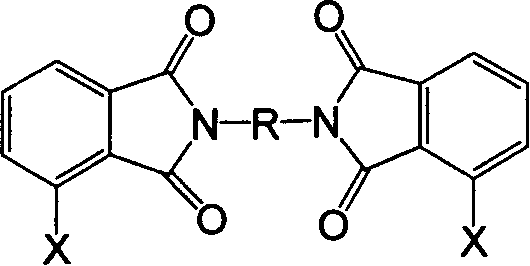Method for preparing polyether imide copolymer by bisubstituted compound and bisphenol
A technology of polyetherimide copolymer and polyetherimide, which is applied in the field of preparing polyetherimide copolymers from double-substituted compounds and bisphenols, can solve the problems of low molecular weight, reduce production costs, and facilitate recycling The effect of reuse
- Summary
- Abstract
- Description
- Claims
- Application Information
AI Technical Summary
Problems solved by technology
Method used
Image
Examples
Embodiment 1
[0038] Add 0.01 moles (2.28g) of bisphenol A, 14.7 grams of diphenylsulfone and 0.02 moles (2.0g) of 40% NaOH solution into a three-neck flask, pass nitrogen to remove oxygen, add 25 milliliters of xylene, and reflux with water for 2 hours Afterwards, add 0.009 mole (4.761g) of 4,4'-bis(4-chlorophthalimide) diphenyl ether, 0.001 mole (0.287g) of 4,4-dichlorodiphenyl sulfone, at 160 ℃ polymerization reaction for 20 hours. The resulting polymer solution was poured into 3% dilute hydrochloric acid in a thin stream, filtered and ground. The solvent was extracted with ethanol, and the intrinsic viscosity of the obtained polymer was 0.32dL / g.
Embodiment 2
[0040] Add 0.01 moles (2.28g) of bisphenol A, 45 grams of diphenyl sulfone and 0.02 moles (2.0g) of 40% NaOH solution into a three-neck flask, pass nitrogen to remove oxygen, add 40 milliliters of xylene, and reflux with water for 4 hours After that, add 0.009 mole (4.761g) of 4,4'-bis(4-chlorophthalimide) diphenyl ether, 0.001 mole (0.287g) of 4,4-dichlorodiphenyl sulfone at 300 ℃ polymerization reaction for 2 hours. The resulting polymer solution was poured into 3% dilute hydrochloric acid in a thin stream, filtered and ground. The solvent was extracted with acetone, and the intrinsic viscosity of the obtained polymer was 0.65dL / g.
Embodiment 3
[0042] Add 0.01 moles (2.28g) of bisphenol A, 45 grams of diphenyl sulfone and 0.02 moles (2.8g) of 40% KOH solution into a three-neck flask, pass nitrogen to remove oxygen, add 25 milliliters of xylene, and reflux with water for 4 hours Finally, add 0.009 mole (4.932g) of 4,4'-bis(4-nitrophthalimide) diphenyl ether, 0.001 mole (0.287g) of 4,4-dichlorodiphenyl sulfone, in Polymerization at 180°C for 200 hours. The obtained polymer solution was poured into 3% dilute hydrochloric acid in a trickle, filtered and ground. The solvent was extracted with acetone and ethanol, and the intrinsic viscosity of the obtained polymer was 0.47dL / g.
PUM
| Property | Measurement | Unit |
|---|---|---|
| Intrinsic viscosity | aaaaa | aaaaa |
| Intrinsic viscosity | aaaaa | aaaaa |
| Intrinsic viscosity | aaaaa | aaaaa |
Abstract
Description
Claims
Application Information
 Login to View More
Login to View More - R&D
- Intellectual Property
- Life Sciences
- Materials
- Tech Scout
- Unparalleled Data Quality
- Higher Quality Content
- 60% Fewer Hallucinations
Browse by: Latest US Patents, China's latest patents, Technical Efficacy Thesaurus, Application Domain, Technology Topic, Popular Technical Reports.
© 2025 PatSnap. All rights reserved.Legal|Privacy policy|Modern Slavery Act Transparency Statement|Sitemap|About US| Contact US: help@patsnap.com



